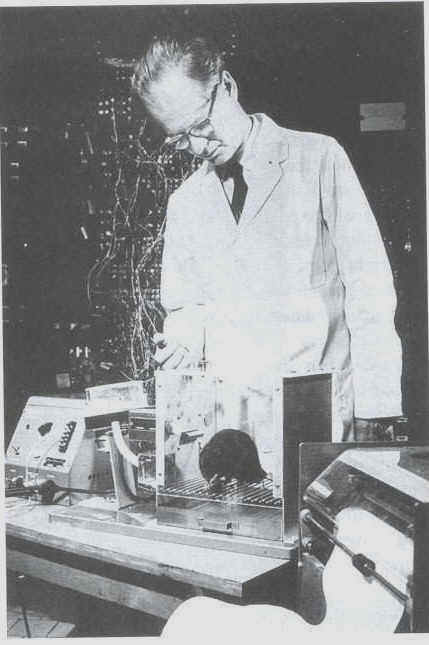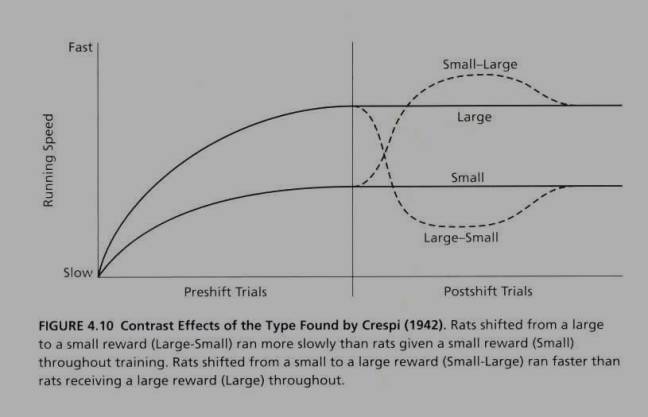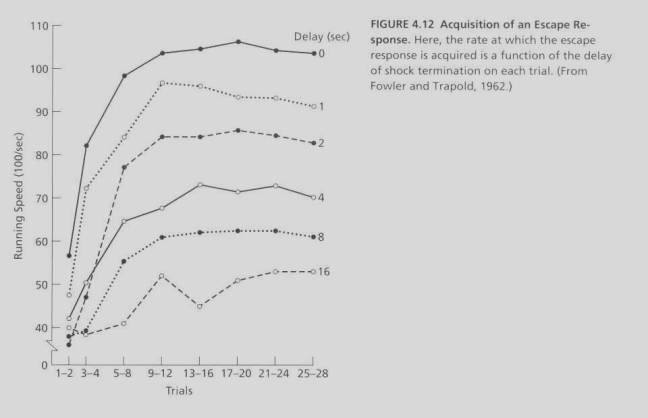
Psy
342 Learning & Memory
Chapter
4
Instrumental/Operant
Conditioning

A. Thorndike

The graph below is called a ______________
and summarizes how quickly cats learned to escape from a puzzle box.
Thorndike's measure of conditioning was _____?

Trial and error or insight?
For Thorndike’s cats, the behaviors that opened the door were followed by certain consequences: __________and____________.
As a result of these consequences, the cat became _____ likely to repeat the effective escape behaviors, which ultimately decreased the animal’s escape latency.
instrumental conditioning—an organism’s behavior changes because of the consequences that follow the behavior.
B. Skinner
Responsible for an enormous increase of interest in instrumental/operant conditioning in the 1940s and 1950s.
How did Skinner’s methods differ from Thorndike’s?
Discrete-trial procedure vs. free operant proceduresResponse latency vs. response rate


II. Behavior, Consequences, &
Contingencies
Instrumental/operant contingency:
Behavior
![]() Consequence (further, this
relationship is contingent)
Consequence (further, this
relationship is contingent)
A. Reinforcement & Punishment
reinforcement—the contingency that results when the consequence of a behavior causes the future probability of that behavior to INCREASE
Then what is a reinforcer?
punishment—the contingency that results when the consequence of a behavior causes the future rate of the behavior to decrease…
Then what is a punisher?
positive
reinforcement—when reinforcement involves the presentation of a stimulus
positive
punishment—when punishment involves the presentation of a stimulus
In this instance, positive does NOT mean __________.
negative
reinforcement—when the consequence in a reinforcement contingency is the removal of a stimulus
negative
punishment—when the consequence in a punishment situation is the removal of a
stimulus
In this instance, negative does NOT mean ___________.

4
key questions to help you determine the type of contingency involved.
B. How
might reinforcers and punishers serve an adaptive role in behavior?
C. Application
Operant conditioning in the treatment of alcohol abuse
One effective treatment for alcohol abuse is the community reinforcement approach (CRA) (Azrin, Sisson, Meyers, & Godley, 1982; Hunt & Azrin, 1973).
Explain the meaning and importance of the following statements:
(1) We define consequences and contingencies by their effects on behavior, not by
what we EXPECT their effects to be.
(2) If behavior is followed by a reinforcer, it is the behavior that is reinforced, not the organism.
(3) The contingent relationship between behavior and outcomes can lead to behaviors that do not appear to make sense.
II. Instrumental Conditioning Paradigms
Instrumental vs. Operant Distinction
A. Runways/Mazes
B. Escape & Avoidance
Paradigms
C. Operant Procedures
Bar-Press
Key-Peck
Human Operant Responses
Measuring Operant Responses—usually rate at which organisms emit response is the dependent variable in most operant conditioning studies
Cumulative recorder creates a record of __________________ as a function of time.

Shaping procedure
Reinforcement of behaviors that are closer and closer approximations of the target response
Application: The Lovaas treatment program (established in 1960's) uses operant conditioning principles to decrease problem behavior of autistic children and to increase the frequency of appropriate behaviors (e.g., language and social skills).
III. Positive Reinforcement Situations
Presentation of an event that increases
the probability of future behavior.
So responding is influenced mainly by
characteristics of the reinforcer.
A. Amount/Magnitude
Generally,
responding occurs faster and becomes more accurate as we increase the amount of
a reinforcer delivered after each response.
E.g.,
Crespi (1942)—5 groups of rats to run down a straight runway for food
IV:
# of food pellets in goal box (1, 4, 16, 64, or 256)
**Results:
After 20 trials, the running speeds of the groups corresponded directly to the
number of pellets received.
Complicating
factor—Some researchers have disagreed as to the definition of reinforcer
magnitude.
Several
studies have shown that if an experimenter gives two groups the same amount of
food for each response, but for one group the food is simply broken into more
pieces, the group receiving the most
pieces will respond faster.
**Quality
of reinforcement also matters.
We
can define quality by assessing how vigorously an organism consumes a reward
when it is presented.
High
quality reinforcers are consumed quickly by organisms, whereas low quality
reinforcers are consumed less quickly.
B. Delay of Reinforcement
Generally, the
longer that reinforcement is delayed after a response, the poorer the
performance of that response.
E.J.
Capaldi (1978)—Two
groups of rats received the same amount and quality of food reinforcement on
each trial.
C. Contrast Effects—Effects
of quantity, quality, and delay of reinforcement on instrumental responding can
vary depending on an organism’s past experiences with a particular reinforcer.
Crespi
(1942)—Group 1 trained to traverse a runway for large amount of food, Group 2
for a small amount of food
After
several trials, the rats receiving the large reinforcer were running
consistently faster than the small-reinforcement group.
Then
switched half of the large-reinf. animals to the small reinforcer being given to
the other rats (large-small).
And
switched half the small-reinforcer rats to the large-reinforcer magnitude
(small-large).

D. Intermittent Reinforcement—Often, we can't reinforce each time an appropriate response is emitted.
What
is the effect of such reinforcement inconsistency on behavior?
It
is clear that instrumental learning is not dependent on continuous
reinforcement. In most species, instrumental responding develops quite
efficiently even when reinforcement occurs only intermittently.
Schedules of Reinforcement

Ratio
schedules—deliver reinforcer only after a certain number of
responses
Fixed Ratio (FR)
Variable Ratio (VR)
Fixed interval (FI)
Variable interval (VI)
Concurrent schedules—when more than one reinforcement schedule is operating at the same time
When
we are faced with choices between different schedules of reinforcement, how do
we respond?
Hernstein
(1961) measured the rate at which pigeons pecked keys that were associated with
different reinforcement schedules.
He
found that pigeons did NOT simply choose the key having the most favorable
schedule of reinforcement. That is, they did not make the vast majority of their
responses to the key that provided the most reinforcement in the shortest period
of time.
Instead,
pigeons divided their responses between the keys, and the rate of responding on
each key was directly related to the rate of reinforcement on that key.

As
a result, Hernstein proposed the matching law
The
formula for the matching law is:
![]()
IV. Negative Reinforcement Situations
A. Escape Learning
Amount of Reinforcement—In escape learning, the amount of reinforcement
corresponds to the degree to which the aversive stimulation is reduced after a
successful response.
Campbell
& Kraeling (1953)—exposed all rats to the same
shock intensity in the runway and reduced
this shock by varying degrees in the safe box.
That
is, all animals received shock reduction after responding, but most animals
still received SOME shock in the safe box.
The
speed of the escape response was a direct function of the degree to which shock
was reduced.
**Escape
learning depends more on the amount of negative reinforcement (degree to which
aversive stimulation is reduced) than on the intensity of the aversive stimulus
per se.
Delay
of Reinforcement—time
between the escape response and the reduction of the aversive stimulation.
Fowler
& Trapold (1962)—exposed rats to shock in an alleyway and required the
animals to run to a safe box to escape the shock.
The
delay in shock offset varied between 0 and 16 seconds.

Results-- escape speeds decreased as the delay of shock offset increased.
B. Avoidance Learning—A stimulus signals the presentation of the aversive
event. The organism must respond in the presence of the signal in order to avoid
the aversive event.
Two
stimuli—the signal and the aversive stimulus
The
characteristics of both of these stimuli are important determinants of avoidance
learning.
Intensity of Aversive Stimulus
Signal-Aversive Stimulus Interval--Avoidance
learning appears to occur most efficiently when the signal and the aversive
stimulus overlap, as is the case in a delayed-conditioning procedure.
Duration of the signal before onset of aversive event--In
general, signals of longer duration tend to facilitate the learning of the
avoidance response (Low & Low, 1962).
Termination of the Signal--Even when the organism’s response results in
avoidance of the aversive stimulus, the rate of learning depends on whether the
response also leads to the termination of the signal.
Kamin
(1957) conducted a two-way avoidance experiment using rats. All rats were able
to avoid shock by moving to the safe chamber during the signal-shock interval.
For one group, the signal terminated as soon as the avoidance response occurred
(o-second delay). In the other three groups, the signal ended either 2.5, 5, or
10 seconds after the avoidance response.

Punishment Situations (Read p. 118-122 for assign. 2)
Intensity & Duration of Punishment
Delay & Non contingent Delivery of Punishment
Responses Produced by the Punishing Stimulus
V. The Discriminative Stimulus
A
stimulus that is reliably present when a particular behavior is reinforced.
After
instrumental conditioning in the presence of a discriminative stimulus, the
presentation of that discriminative stimulus will increase the probability of
behaviors that have been reinforced in its presence….
Discriminative
stimuli make a behavior more probable, but ultimately they DO NOT CAUSE the
behavior to occur. It is the reinforcement contingency that controls the rate of
behavior.
VI. Extinction
Variables Affecting Extinction of Positively Reinforced Responses
Conditions Present During Learning
Conditions Present During Extinction
Variables Affecting Extinction of Negatively Reinforced Responses